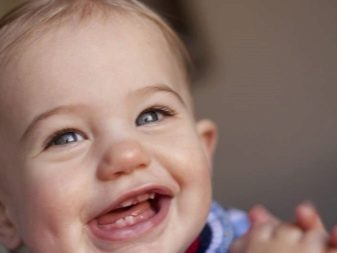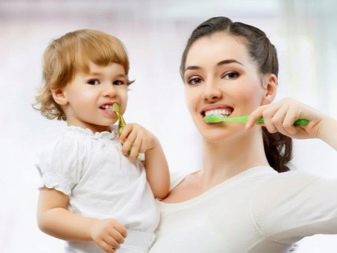How to brush your child's teeth at 1 year old?
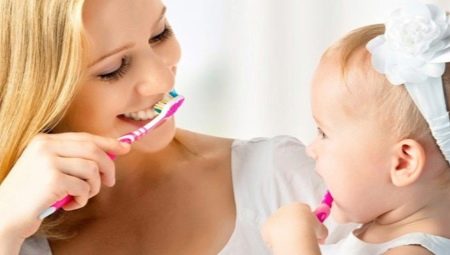
Every parent wants only the best for their child. The same applies to dental health. It is very important not only to start taking care of oral hygiene on time, but also to instill in the future a love of dental care. To prevent the occurrence of undesirable problems even at the stage of the growth of deciduous teeth, great attention should be paid to oral hygiene, since the condition of deciduous teeth strongly affects the molars.
This article will help young parents figure out how and when to start caring for their teeth, as well as how to help their child cope on their own.
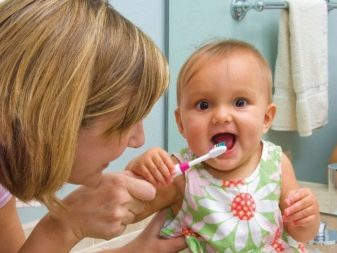
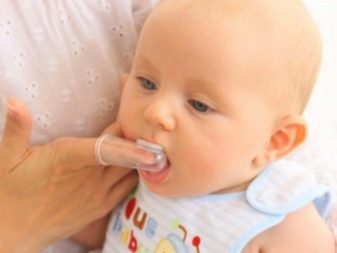
What should be the brush?
The main assistant in the fight against caries is a toothbrush. It is on the chosen "tool" that the quality of cleaning will depend, and hence the further health of the teeth. There are several criteria to choose a brush for your baby.
- Artificial fibers. They are softer than natural counterparts, so damage to the gums or sensitive enamel will not work. In addition, microorganisms accumulate and multiply faster in natural bristles.
- A pen. It is desirable that it be thick enough and embossed, possibly with rubber inserts. In the future, this will help the baby get used to the process faster. This brush will be comfortable to hold in your hands, it will not slip.
- Brush head. It is not recommended for children to use a brush thicker than 2.5 cm, so that the bristles do not touch more than two teeth.
- Bristle cut. It is important that it is flat to ensure even pressure on the teeth. At this age, children often find it difficult to control the pressure of the brush on the enamel.
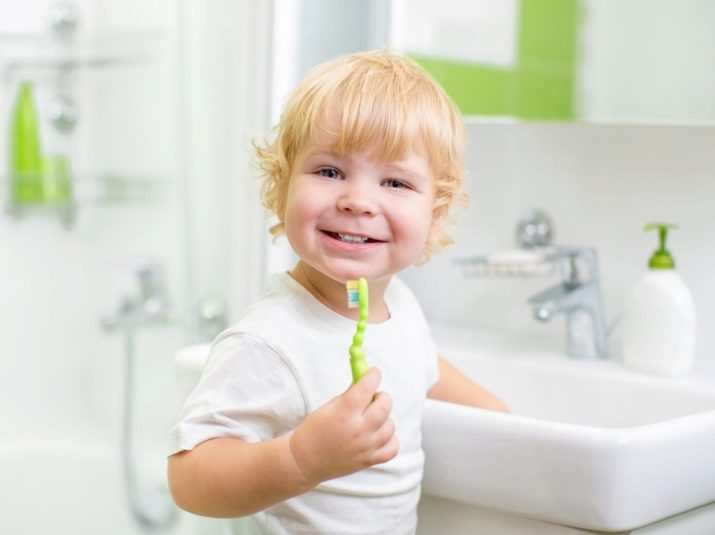
It will be possible to switch to brushes of medium hardness not earlier than 4 years.In addition, it is worth giving up the electric toothbrush until the moment when the child begins to confidently use the toothbrush - until the age of 6.
What tools can you use?
If you want to start caring for your child's teeth earlier, then you can use a special silicone toothbrush or an irrigator. First, care involves cleaning the gums, mucous membranes of the cheeks and tongue once a day. This topic is especially relevant if the child has a predisposition to diseases of the oral cavity. On this occasion, it is better to consult a dentist, but as for brushing teeth for a child at 1 year old, things are different here. At this age, it is already necessary to pay more attention to the toothpaste and its composition.
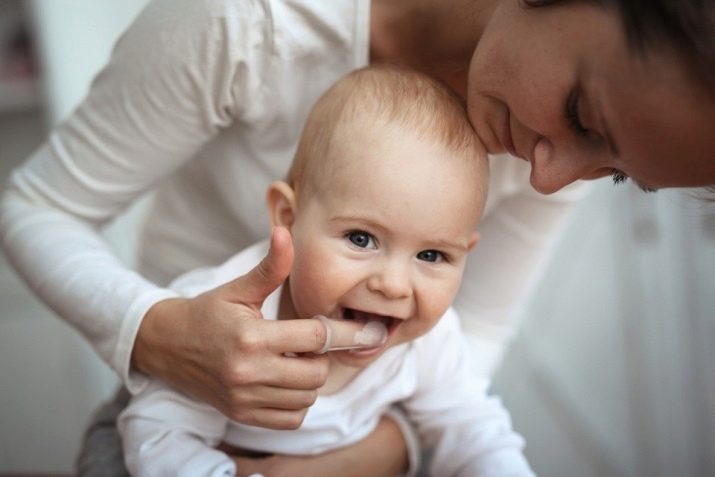
Due to the fact that babies at this age still do not know how to rinse their mouths correctly, it is extremely important to choose a paste according to its composition so that it does not contain substances harmful to the child's health. Here are some expert tips for choosing children's toothpaste.
- Fluorine. This element is taboo for children's toothpaste. A large amount has a toxic effect on the adult body, what can we say about the child.
- Milk protein casein. It also has a bad effect on the well-being of the baby and the health of his milk teeth. The amount of this substance should not exceed 22 cu. e.
- Antibacterial elements. This is a prerequisite for the composition of children's toothpaste. Such substances are necessary to prevent inflammation and the growth of bacteria. Since at this age the mucous membrane is still quite sensitive, therefore, there can be no mint or coniferous additives. Elimination of unpleasant odor occurs due to antibacterial microelements.
- Foam toothpastes. There is nothing dangerous in them, but parents should remember that a large amount of foam can dry out the oral mucosa. At an early age, this can also provoke allergies, so it is better to save this paste until preschool age.

Another nuance that is best not to be missed is the amount of toothpaste. If an adult can afford to squeeze out more funds, then a small pea will be enough for a one-year-old baby. Don't overdo it.
Cleaning technology
The correct technology for brushing your teeth is a guarantee of a beautiful smile and healthy teeth. The sooner a child learns to care for their teeth on their own, the less likely they are to have to deal with frequent visits to the dentist.
Let's figure out how to teach your child a simple and effective technique for brushing your teeth.
- The toothbrush should be held at a 45 degree angle to the gum.
- Technique "Janitor". The upper teeth should be cleaned with sweeping movements starting from the top, and the lower ones, on the contrary, from the bottom up.
- Technique "Swing". The inner and outer sides must be cleaned with a left-right brush movement. The same goes for the chewing surface of the teeth.
- The Bully Technique. The back of the brush (if there is a special surface) or the bristles itself should remove plaque from the tongue.
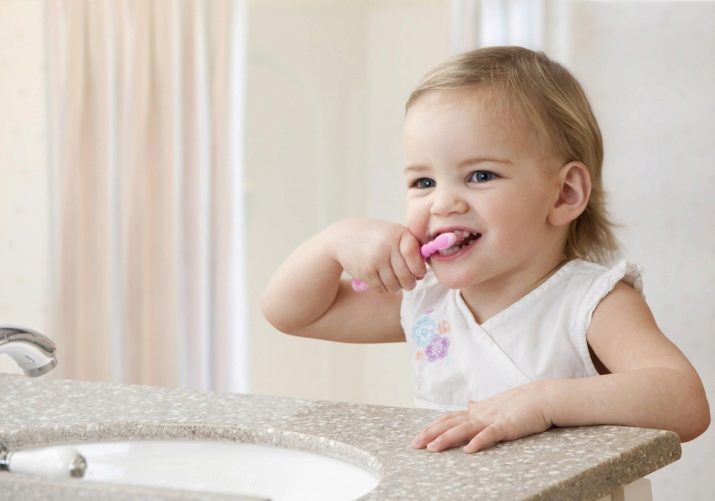
After the cleaning process is over, you need to rinse your mouth and clean your toothbrush. If the baby copes with the latter without much difficulty, then rinsing your mouth is better to help. To do this, you should either have a special glass from which it would be convenient to take water into your mouth, or collect water in your palm. Do not miss the last moment - storage of hygiene items, otherwise the whole ritual will go down the drain. So that bacteria do not start on the brush, and it does not have to be changed ahead of time, it is important to explain to the child why it is important every time to put a cap on the bristles and put the toothbrush in its place.
If the baby grows up independently and does not give help, then you can allow him to brush his teeth on his own, and then check how he did it, and, if necessary, clean it or suggest what to do.
And also let him check the quality of your dental care.Most likely, the baby will like this process.
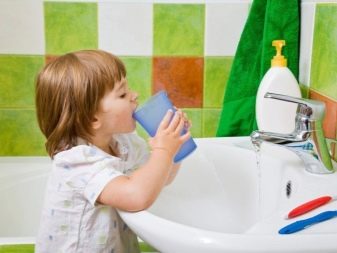

How to teach self-care?
It is a very bad idea to let the oral hygiene process go by itself. In most cases, children are too lazy to brush their teeth, so this should be monitored. Otherwise, the risk of diseases such as tonsillitis, problems with the gastrointestinal tract and teeth increases.
To teach and accustom your child to brush his teeth every day, it is important to start this process at the age of one. It is then that children begin to copy the behavior of adults from their close environment.
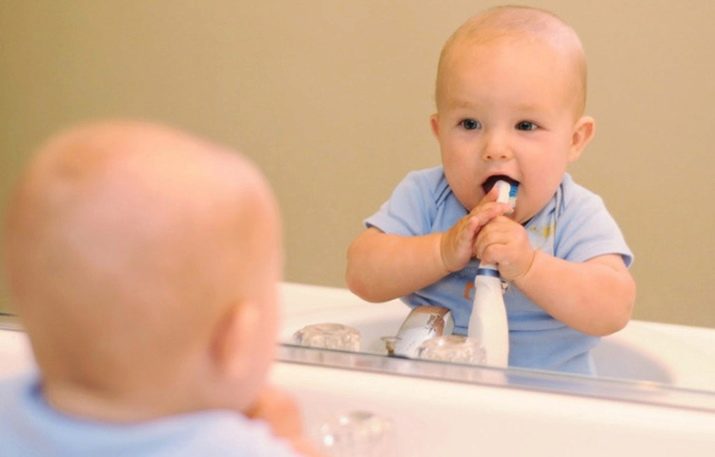
Consider what rules should be followed in order to teach a child to brush their teeth on their own.
- Become a team. It is enough to make brushing your teeth a family daily ritual, when the whole family gathers in the bathroom and brushes their teeth. In most cases, children love this idea, and they happily repeat it day after day.
- Make hygiene a game. You can think of some conditions that would help not only to captivate the child, but also to remember the technique of brushing your teeth. And you can also play dentist so that the kid brushes the teeth of one of the adults, and this process may become more interesting for him in the future.
- Please brush. When none of the methods work, you can try giving your baby the opportunity to choose a toothbrush on their own. If he likes her, he will want to hold her in his hands more often, which means that the process of dental care will no longer be so boring and unloved.
- Passion for the process. In this case, you can try to captivate the child with some thematic poems or fairy tales. And also this technique will help to focus the attention of fidgety children.
However, keep in mind that quality is not as important in the learning process as engagement.
The main thing is that the baby is not afraid and feels relaxed during the dental care process. The child will always have time to catch up with the technique, but it is important to acquire a habit on time.
